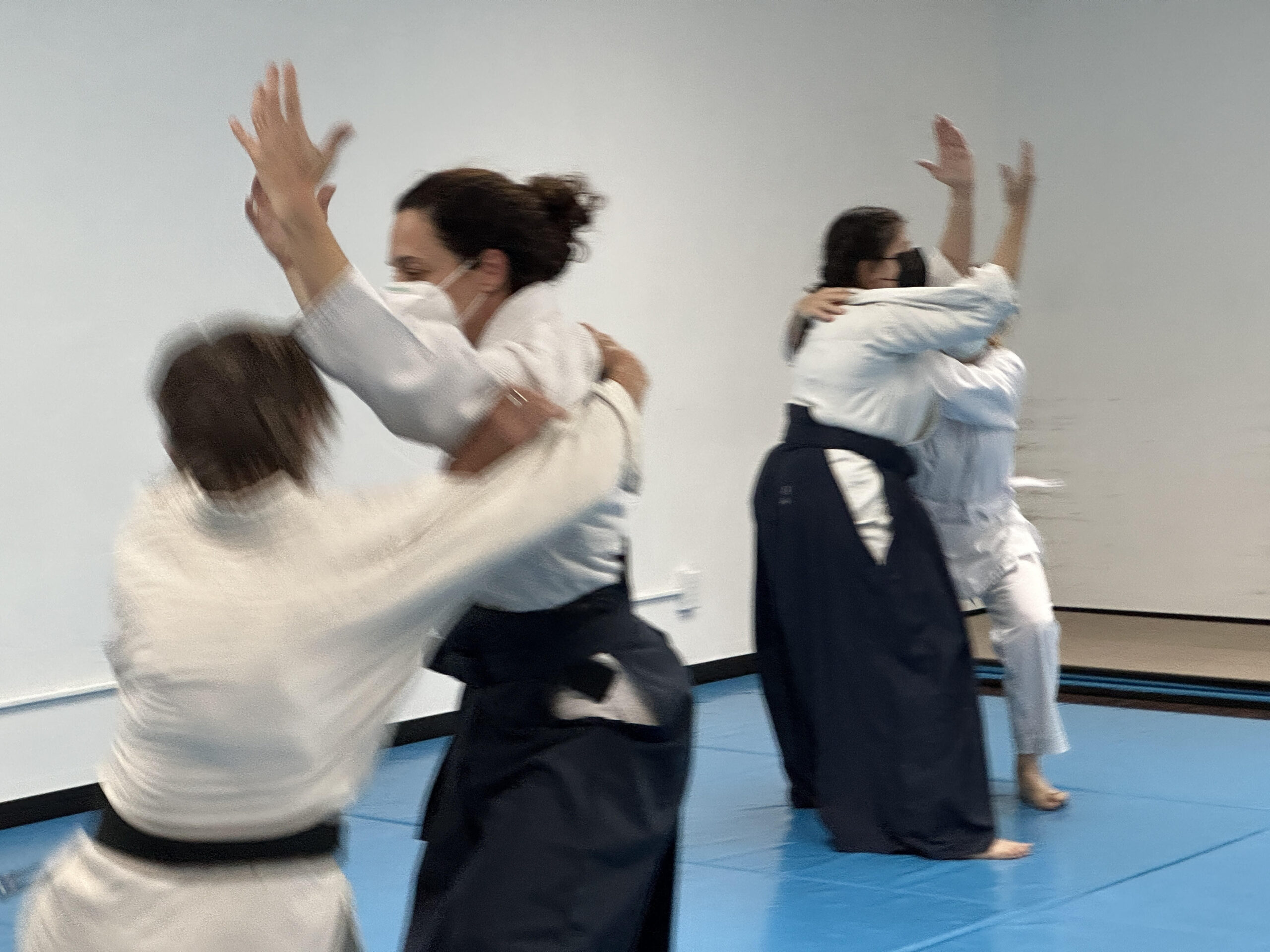I love it when aikidoka from other dojos come play with us. It’s fun to meet people from all over the world, and to learn a little about how things are done in other places. I don’t travel a lot, but if I did I’d sure want to visit other dojos, meet folks there, and get my Aikido fix!
I’ve been to a few other dojos for seminars, talked to a lot of people from other schools, and have sometimes been confused when trying to figure out how things work in new situations. So here are a few pointers for figuring out “the way things are done” that might help you feel more at home when you are visit another dojo.
Tips for visiting other Aikido dojos:
- Most Aikido dojos welcome visitors. Knowing the affiliation or lineage can be interesting, though. The dojo where I train for instance, Aikido of San Diego, is affiliated with Aikikai, through the California Aikido Association (CAA), under Division 3, headed by Robert Nadeau Shihan. [Update: Aikido of San Diego is now part of the Evolutionary Aikido Community, headed by Patrick Cassidy Sensei in Montreux, Switzerland.] In any case, check with the sensei or dojo cho before visiting. A call or email requesting to come visit and train is usually appreciated. If you aren’t told about a mat fee, be sure to ask/offer. It’s best to bring some cash for this purpose. In my limited experience the mat fee is typically about $20. Don’t expect the dojo to be prepared to make change for large bills.
- Notice (or ask) how instructors and others addressed. At our dojo only Goldberg Sensei is addressed as “Sensei”. At some dojos any instructor who is teaching at the moment is addressed as “Sensei.” Still others may say “Senpai” for instructors who aren’t the head of the dojo. Senpai means a senior student.
- Are belt colors used? If so, they can help clue you in to the level of your training partners. We have a few belt colors (6 & 5 = white, 4 & 3 = blue, 2 & 1 = brown), and only yudansha wear hakama. In some schools. however, belts are white for all kyu ranks. In others, almost everyone wears hakama. So don’t assume that people wearing white belts are newbies, or that those students wearing hakama are yudansha (black belts).
- Do students line up according to rank? At every dojo where I’ve trained, and in the seminars I’ve been to, people do not line up in any particular order. But at some dojos, people do line up according to rank, so keep your eyes open to figure out where you should sit.
- Do they clap when bowing in and out of class? We usually don’t clap when we bow in. In some schools, the instructor leads bows with two claps, or sometimes four. Always follow the instructor’s lead.
- Who trains with whom? In many schools, everybody trains with everybody else. At the dojo where I train, lower-ranked students are encouraged to approach senior students and ask them to train. But at some dojos the students train only with others near their own rank. In some schools lower-ranked students are expect to not approach seniors, they should wait to be asked.
- Do students change partners during class? At Aikido of San Diego, we usually change partners several times throughout the class. At some dojos you stick with the same partner through the whole class.
- Two times? Four times? In some places you try a technique two times, and then switch with your partner, while in others each partner does the technique four times before switching.
- May students step off the mat during class? In many dojos it is OK for participants in classes to unobtrusively step off the mat for water (we often keep a water bottle near the edge of the mat), or to go to the bathroom if you must. Do this during training times, never when the instructor is demonstrating a technique or speaking. At some dojos leaving the mat for any reason is strongly discouraged, and you should at least ask first (don’t just duck out). If you think you might need to excuse yourself during class, ask a local student how things are done, or just watch the others who regularly train there.
- How do you re-join the class? Also notice (or ask) how you should return to the mat, if you step away during class. We bow in without interrupting the class and return to training, and a standing bow is OK. At some dojos you would wait, seated in seiza, at the edge of the mat for the instructor to allow you back into the class, and do a seated bow when you are acknowledged.
- OK, eleven things. Here’s a bonus tip: Is there a mat or towel where you should wipe your feet before stepping onto the mat? This is more common in a dojo with concrete or wooden flooring, because it’s so easy for everyone to track bits of dirt onto the mat. If the dojo is carpeted people’s feet usually stay cleaner. If there is a mat or towel available you should only step onto the mat there, after wiping your feet. I have only seen this once, but I’m so glad one of my senpai told me about it, so I knew to look for it, and what to do.
If there’s anything you aren’t sure of, just ask. The students and instructors will be happy to explain things. Try your best to do techniques as they are taught there, rather than stubbornly sticking to the way you’re used to. Keep your eyes and ears opens to new ideas, and enjoy training with your new friends!
When others come to visit your dojo…
When people visit the dojo where you train you can put them at ease by helping them understand how things are done. You may notice them glancing around, trying to figure out before class starts where they should sit in line, and so on.
I usually introduce myself, let them know where the restroom (and key!) are, and give them a quick run-down of some basics about our classes: “We don’t line up in rank order, it’s OK to step off the mat to drink water or visit the restroom, and everybody trains with everyone, regardless of rank.” You can see the relief!
Everyone appreciates knowing what’s expected of them, and nobody wants to make a mistake as a guest.
Come train with us in San Diego.
If you are in the San Diego area on business or vacation, come visit us at Aikido of San Diego. It’s best to call ahead. You will be welcome. You can find directions, mat fee, contact info, etc. at AikidoSD.com.





